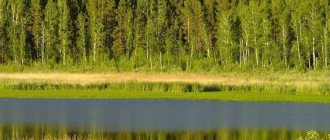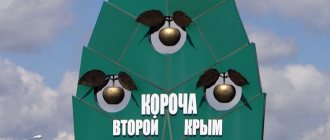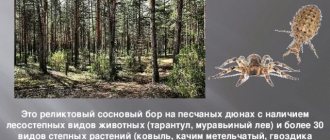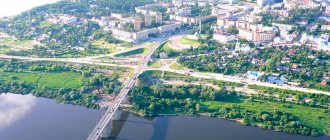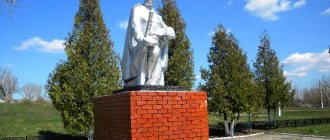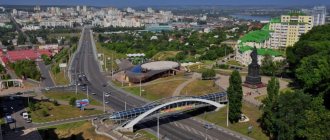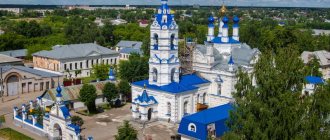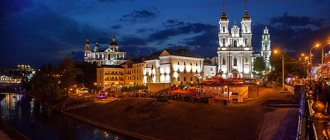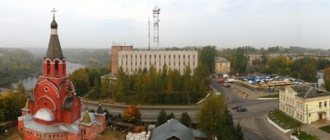The Belgorod region within its modern borders was formed in 1954 and is located in the Central Federal District of the Russian Federation. During their history, these lands were part of the Khazar Kaganate (from the 8th century), after the military campaign of Prince Svyatoslav against the Kaganate in 965, the lands joined Ancient Rus', from the 12th century. was part of the Chernigov principality.
In these places, in 1571, attempts began to draw the first borders with the Crimean Khanate, which gave rise to the formation of the Russian border service and army. During the Second World War, the territory of the Belgorod region was occupied by the Germans and liberated only in 1943 during the Battle of Kursk; the famous Prokhorov tank battle took place in these places.
The Belgorod region is rich in beautiful natural places - numerous streams and small rivers, swamps and ponds, reservoirs, springs of mineral waters, unique in their composition. On the territory of the region there are many oak forests, deciduous forests, meadows, and steppe areas, which are densely populated by representatives of the animal world (up to 12 thousand species).
State Nature Reserve “Belogorye”
One of the most famous and beautiful natural sites in the Belgorod region is the Belogorye state reserve with an area of 2131 hectares, founded in 1999 and consisting of 5 separate areas with their own characteristics.
The “Forest on Vorskla” section is the oldest place in the reserve, which preserves a centuries-old upland oak grove on Vorskla, the age of some trees reaches 300-350 years. The forest is inhabited by about 100 species of birds (pygmy eagle, black kite, gray owl, etc.), wild boars, European roe deer, foxes, badgers, weasels, brown hares, stone martens, etc.
The Ostrastyevy Yary site is a dense network of gullies and ravines reaching a height of 200-250 m. The vegetation of the site is typical for the forest-steppe zone - more than 362 plant species: fescue, feather grass, sage, astragalus, flax, etc. The fauna of these places is represented by roe deer, foxes, hedgehogs, mole rats, long-eared owls, buzzards, newts, several species of toads and frogs, etc.
The Stenki-Izgorya site is located in a floodplain area and on the river slopes of Oskol. The most beautiful places in this zone are the numerous beams with narrow ridges. The main value of the site is the relict chalk pines, the average age of which reaches 200 years.
The Yamskaya Steppe site can boast of its chernozem soils with characteristic beautiful steppe landscapes. This place is the only large tract of virgin feather-grass-forb-meadow steppe in the world on typical chernozems, thanks to which it was awarded a diploma from the Council of Europe and named the standard of steppe ecosystems in Eurasia.
The Bald Mountains site is unique in that the process of active relief formation is still ongoing. This beautiful place is covered with chalk outcrops formed by the erosion of water after the last glaciation.
White Mountains of Belogorye...
Hello, today I want to tell you a little about the Belgorod region... and in particular, talk about the White Mountains. The White Mountains are not only fabulous landscapes merging with snow-white clouds, they are also an ancient natural monument that tells visitors about the multimillion-year history of the creation of the Earth. So where did they come from, what can they tell us, what do they remember? The geological history of the Earth is divided into periods with characteristic features of the formation of rocks, communities of organisms and climatic patterns. The Cretaceous period is the last of the Mesozoic era, and dates from 145-65 million years ago. The Cretaceous period was identified by the Belgian geologist Jean Baptiste Julien d'Aumalius d'Allois in 1822.
The chalk layers on the Central Russian Upland were formed about 90 million years ago in the basin of the Turonian Sea, which stretched from the territory of present-day France to Western Siberia and covered the entire southern Europe. Chalk comes to the surface in the valleys of almost all major rivers in the region and on watersheds. Chalk mountains and rocks and cliffs are found in the Belgorod, Volgograd, Voronezh regions of the Russian Federation.
Thus, the chalk mountains are nothing more than the bottom of ancient seas, formed by sediments of dead organisms (mmonites, belemnites, brachiopods, bivalves, sea urchins, etc.), which mixed with inorganic material and formed deposits of a kind of silt. During geological processes, sections of the earth's crust that were the bottom mixed, rose above sea level, forming land, and then were washed away again by rivers and seas. As a result, ancient sedimentary rocks were exposed in the valleys, in which fossils of plants and animals were preserved. On the chalk slopes you can easily find the remains of extinct belemnite mollusks, which are often popularly called “devil’s fingers” or “thunder arrows”.
In Belgorod mythology there are many legends about gold hidden by rich Moscow merchants in the chalk caves of Belogorye, about nymphs, inhabitants of the White Mountains and of course about the Mistress of the White Mountains!
Some chalk mountains have a peculiarity - if you stamp hard, it begins to hum in response from the inside. Scientists explain this by the formation of voids inside the Cretaceous rocks. Yes, this is not just a hum, a whole song, which is accompanied by a uniform beat that matches the rhythm of the heartbeat. Regarding this song of the chalk mountains, there is also one very interesting legend about a terrible battle with Indra.
Today I walked through the chalk mountains, for our puppet competition I created the image of Orestiada - the goddess and mistress of the White Mountains (more on this in the next topic) and along the way took several photographs of the area (some photographs were already in my albums from past photo shoots). My child was in seventh heaven from such a walk and while I was busy taking photographs, he rolled down the mountains, where there is a soft chalk embankment... I have never seen him so white and dirty - I can’t even describe it in a fairy tale!!!! )))))
And such cars happen after driving along the road among the White Mountains)))))) today my car was about the same))))
In 2007, a sculpture of a chalk miner appeared at the roundabout of Studencheskaya and Melovaya streets. It is not surprising, because the Belgorod region is one of the largest chalk deposits in the country. The monument personifies the hard worker, thanks to whom Belgorod developed.
>
Holy Trinity Kholkovsky Monastery
One of the most beautiful monasteries in the Belgorod region is the Holy Trinity Kholkovsky Monastery, founded in the 17th century. on the bank of Oskol at the confluence of the Kholka. A distinctive feature of the monastery is that the existing underground Trinity Church and cells were cut right into the chalk mountain, and then a more modern temple complex was erected on top.
It is not known for certain who dug the caves and when, but their dimensions are impressive - the total area is 255 m2, the area of the church is 60 m2, the cells are 172 m2, the length of the corridors is about 126 m. The first above-ground structure of the monastery is a wooden gate chapel (1757), then – Transfiguration ground temple.
The monastery was abolished in 1764 by decree of Catherine II. In the 19th century Services were held in the Transfiguration Church, but the underground church and monastery were abandoned, the entrance to them was filled up and almost forgotten until it was accidentally discovered by the priest of the village of Kholki, Father Vyacheslav Vasilchikov. After many years of difficult excavations, the monastery and underground temple were dug up, opened to the public in 1990, and services resumed in 1995.
Belgorod region: nature
The settlement occupies an L-shaped cape on the right bank of the Koren River. Eight hundred years ago, a large ancient Russian city stood here, protected by high ramparts, deep ditches and impregnable chalk cliffs.
The first archaeological excavations carried out in 1995 made it possible to indisputably establish that we are talking about a valuable monument of Russian history and culture, preserving traces of several historical eras - Scythian times, early Slavic and Old Russian. At the same time, it was possible to prevent the final destruction of the ancient settlement, the slopes of which had long been used for chalk mining. Fortunately, local authorities listened to the arguments of archaeologists and took the site under protection.
The “Krapivenskoe settlement” - a convenient place above the river, well protected by natural obstacles - has been inhabited more than once over at least the last two thousand years. The earliest traces of ancient culture discovered on it date back to the 5th-4th centuries BC. e. They belonged to the local forest-steppe, as well as, probably, to an alien, presumably Scythian settlement. In the 9th century, on the site of a fortified settlement of the Scythian era, a fortified settlement of the chronicle “severa” arose - a tribal union that, together with the “glades,” formed the ethnic core of Kievan Rus. At the beginning of the 10th century, the settlement was abandoned - the Pechenegs burned it. At the beginning of the 12th century, the upper reaches of the Seversky Donets were again reclaimed by the ancient Russians. The settlement on the Koren River is also coming back to life. The influx of settlers here was so powerful, and the place was so important militarily, that from the very beginning a fortress city was built here, and not an ordinary “heroic outpost.” The settlement turned out to be the largest fortification in the extreme southeast of Ancient Rus'. Only the chronicle Donets, the fortified settlement of which is located on the outskirts of Kharkov, is comparable to the “Krapivensky settlement”.
In the middle of the 13th century, the ancient Russian city, along with many other settlements of southern Rus', perished in the fire of the Mongol invasion. Only more than three centuries later, in the 14th-17th centuries, life began to warm up again at the site - traces of the settlement from that time were found.
But one mystery in the history of the monument still remains unsolved - what was the name of this ancient Russian city. The settlement is now called “Krapivensky” only because it is located near the modern village with that name. It is known that near Tula, on the Zasechnaya Line, already in the middle of the 16th century there was a small town called Krapivna. It is likely that the people who moved from there in the 17th century gave the name to the Belgorod village. Actually, the ancient Russian city is not mentioned in any chronicle. Only the 12th-century Arab geographer Al-Idrisi notes six Russian cities that then stood in the basin of the Rus River (Seversky Donets). One of them, apparently, is a city on the “Krapiven settlement”. Perhaps Al-Idrisi has it under the name “Busara”.
At the top of the mountain there is a memorial stele: on a stainless steel shield there are three spears directed upward, personifying the power and strength of Russian warriors, and three arrows, symbolizing hostile forces - the Khazars, Pechenegs and Polovtsians... These memorial signs were installed thanks to the efforts of a passionate person, a local historian — Alexander Vasilyevich Bespoyasov.
Prokhorovskoe field
One of the most famous military museum-reserves of military history is located in the Belgorod region - this is the Prokhorovsky field, the site of the tank battle of the same name with the German invaders in 1943 during the Battle of Kursk.
The historical complex, formed in 1995, included: the three-domed snow-white church of the holy apostles Peter and Paul, on the marble walls of which 7,000 names of soldiers who fell on the Prokhorovsky field are inscribed; a beautiful 50-meter belfry, decorated with a 7-meter sculpture of the Intercession of the Mother of God; Bell of unity of three fraternal peoples (2000) - Russia, Ukraine and Belarus; numerous sculptures, mass graves, a museum of military tank equipment and many other beautiful and interesting places.
Animals and birds of the Belogorye Nature Reserve
On the territory of the Belogorye Nature Reserve, 62 species of mammals and 180 species of birds have been registered. Among the forest inhabitants are typical representatives of this region: roe deer, wild boar, squirrel, marten, fox, brown hare. The common beaver is found in the floodplains of rivers. Rare inhabitants include ermine, weasel, raccoon dog and badger.
Open steppe areas are inhabited mainly by rodents, as well as representatives of the orders of chiroptera and insectivores. There are occasional visits by wild boar, wolf or roe deer. In areas with grass, you can find the European bobak marmot.
Site Bald Mountains, ©
Among the bird diversity, some species nest on the territory of the reserve, and some of them stop temporarily during migration. Most often in the forest areas of Belogorye you can see: woodpecker, goshawk, pika, tawny owl, blue tit, great tit, buzzard, jay, oriole, nightingale, chaffinch, goldfinch and many other birds familiar to the middle zone.
Under the protection of the Red Data Book of the Belgorod Region and Russia, several representatives of the avifauna of the reserve: the dwarf eagle, the little flycatcher, the middle woodpecker, the redstart, the nightjar, the buzzard, the shelduck, and the white stork. The bird population of the steppe and mixed lands includes: skylark, warbler, warbler, stonechat, gray shrike, greenfinch and bunting.
Among the waterfowl and semi-aquatic birds that stop on migration and nest in the reservoirs of the reserve, we can distinguish: mallard, rare gray crane, moorhen, black duck, and reed bunting.
© Usenkolk
Gubkinsky Transfiguration Cathedral
Gubkin Spaso-Preobrazhensky Cathedral is one of the most beautiful and majestic not only in the Belgorod region, but also in Russia. In terms of area, it is second only to the Cathedral of Christ the Savior in Moscow, receiving 3,000 people during services in the main hall alone.
This incomparably beautiful place was consecrated in 1996 by Alexy II, and now, with the blessing of Belgorod Archbishop John, painting of the interior of the temple has begun. The Transfiguration Cathedral was built in the form of a 5-domed church in the shape of a cross, its height reaches 50 m, the total cost of construction cost $ 4 million, of which almost half were donations from parishioners of the Belgorod region and throughout Russia.
Project on the topic “Diversity of nature. Belgorod region" for 3rd grade
Goal of the project: As part of studying the subject “The World Around us”, talk about the nature of our native land.
Find information about the diverse nature of the area and share it with classmates. Tell schoolchildren about the plants and animals found in our places. Prepare a report and presentation in the form of a photo story. Project plan:
- Introduction.
- Plants.
- Animals.
- Red Book.
- Protection of Nature.
- Conclusion.
- An example of a finished photo story-presentation.
Palace complex of the Yusupovs in Rakitny
The Yusupov palace complex in the village of Rakitnoye is one of the most beautiful historical sights of the Belgorod region. These beautiful places attracted members of the princely family so much that for almost 200 years they owned Rakitnaya Sloboda, building a two-story palace in 1840 on the initiative of Boris Nikolaevich Yusupov.
The palace took almost 6 years to be built by the prince's serfs, and the project was developed by the capital's best architects, including the Italian Giacomo Florenti. The architecture of the palace harmoniously combines elements of classical, baroque and Russian architecture. A cascade of beautiful ponds was created on the palace grounds, and a park was laid out around it.
This beautiful place was the autumn home for the Yusupovs, who lived according to a rigid schedule of changing residences. After the revolution, the estate was nationalized and a auxiliary boarding school for children from the Belgorod region was placed there. Since 1994, a museum of the Yusupov princes has been opened in part of the former palace.
Report to the project
Our region is located in the center of the East European Plain and has no access to the seas. Its territory is relatively small in area, it is only 67th among other regions of Russia. But the nature of our region is amazing and diverse.
The climate of the region is temperate continental, winters are mild, the soils are very fertile - black soil. The region is located within the natural zones of deciduous forests and forest-steppe. The relief is flat, with numerous hills.
There are many places in the region that are unique in their beauty and have been awarded the title of Natural Monument. This is the Monastery Cave, picturesque springs in different places in the region, relict forests of chalk and Crimean pine.
We don't have high mountains. The highest point of the region lies at an altitude of 277 meters above sea level. But there are many rivers in our region, the largest of which are Oskol and Seversky Donets.
Vegetation
The main plant of our forests is oak. There are quite a lot of oak forests in the region. Along with the oak trees, ash, linden, and maple grow, and rowan and bird cherry trees are found. But there are also forests in the region consisting of birch and aspen.
A characteristic feature of the forest-steppe is the presence of thickets of shrubs, consisting of thorns, rose hips, and wolfberry.
Meadow and steppe vegetation is abundantly represented in the region. These are various meadow flowers and herbs, including cornflower, blueberry, sow thistle, iris, hyacinth, tulip, umbrella and grain plants.
Animal world
The fauna of the region is also very diverse. We have especially many representatives of the order of rodents - voles, mice, marmots, gophers, and mole rats. Hares, wolves, ferrets and foxes are found both in the forest-steppe zone and in forests. Elks, wild boars, and roe deer are also found in the forests; beavers are easy to spot along reservoirs.
The birds of our region are represented primarily by birds of the order Passeriformes, Anseriformes and Raptors. These are crows, tits, nightingales, bustards, geese, swans, ducks, hawks, and eagles.
There are a lot of fish in the rivers of the region. The most common species are bream, roach, carp, and crucian carp; less often you can see catfish, dace, and river lamprey.
Red Book of the region
Despite the great diversity of flora and fauna in the region, nature needs constant protection. The Red Book has been created in the region, which includes 269 species of animals and 213 taxa of plants and fungi that need protection.
Among the mammals in the book are the muskrat, the steppe polecat, the European mink, and the bandage. Birds include the whiskered tit, millet, redstart, roller, nightjar, scops owl, eagle owl and others.
Among the rare plants we mention Russian hazel grouse, Bieberstein tulip, curly lily, two-leaved scilla and slender fennel.
Nature conservation activities
The main environmental threat in our region comes from agricultural enterprises. Huge areas are used for arable land and pastures, and the area of true steppes and meadows is constantly shrinking. The region is actively engaged in environmental protection activities; the Department of Environmental Reproduction has been created under the regional government.
To preserve natural ecosystems, the Belogorye Nature Reserve, two natural parks - Khotmyzhsky and Rovensky, as well as more than a dozen different reserves were created.
Conclusion:
The flora and fauna of my region is very diverse. But if you don’t take care of nature and protect it, then this diversity can quickly disappear. Therefore, it is the duty of every responsible person to fight with all his might for the preservation of plants and animals, and nature as a whole. Let's save nature together!

